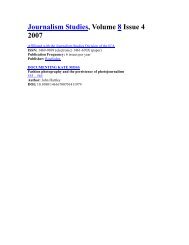GrowinG Future innovators - ARC Centre of Excellence for Creative ...
GrowinG Future innovators - ARC Centre of Excellence for Creative ...
GrowinG Future innovators - ARC Centre of Excellence for Creative ...
Create successful ePaper yourself
Turn your PDF publications into a flip-book with our unique Google optimized e-Paper software.
What happens is we join up two schools<br />
across the world via another hub gallery<br />
or arts organization. We’re trying to<br />
encourage them to go to their local one<br />
but use us as a catalyst. The program is<br />
based online where they share in<strong>for</strong>mation<br />
and ideas and eventually artwork.<br />
As an example, one school from India sent<br />
a series <strong>of</strong> photographs to their English<br />
school and the English school did the<br />
‘be<strong>for</strong>e and after’ photographs <strong>of</strong> what<br />
they interpreted. To imagine, to look at<br />
the composition, it’s all a brilliant way <strong>of</strong><br />
encouraging people to learn how to look<br />
closely, because it’s got incredible purpose<br />
to it <strong>for</strong> them—they try to find out about<br />
each other.<br />
The relationship between the paired schools<br />
is <strong>for</strong>ged throughout a year <strong>of</strong> joint enquiry,<br />
assisted by artist-designed project packs.<br />
Various kinds <strong>of</strong> artistic media can be used<br />
and the creative results are uploaded onto<br />
the project’s online gallery.<br />
As the contemporary art sector has built<br />
this reputation <strong>for</strong> experimentation, it<br />
has become a beacon <strong>for</strong> business and<br />
community organisations seeking to engage<br />
with innovative practice and learning. Jenny<br />
Simpson observes that “the more businesses<br />
and organizations get hemmed in, I think<br />
that drives their need to think about things<br />
differently, and they look toward companies<br />
like AWESOME Arts to build their own<br />
ideas and their thinking.” In describing her<br />
experience <strong>of</strong> partnering with industry and<br />
community, she says “They come to us and<br />
say, ‘We’ve got this great idea. You people<br />
are crazy enough to do it. Let’s give it a<br />
try’. Andrew Clark from the Queensland<br />
Art Gallery explains this by saying, “they’re<br />
attracted to the gallery because, to them,<br />
we’re presenting creativity, and in the whole<br />
corporate world at the moment there is big<br />
talk that the businesses that will survive in<br />
the 21st Century are the <strong>innovators</strong>, are the<br />
creative ones.”<br />
In Australia, building capacity through<br />
community and arts organization partnerships<br />
is now a priority. This is reflected in federal<br />
government policy and programs such as the<br />
“<strong>Creative</strong> Communities Partnership Initiative”<br />
<strong>of</strong> the Australia Council <strong>for</strong> the Arts, designed<br />
to stimulate innovation across arts and nonarts<br />
sectors.<br />
Business and community partnerships<br />
<strong>for</strong> Serpentine Gallery’s Edgware Road<br />
project grew to involve local residents and<br />
shopkeepers, and a project base was installed<br />
in the local neighbourhood called The <strong>Centre</strong><br />
<strong>for</strong> Possible Studies. Modeled in many ways<br />
like a school, projects are structured around<br />
three terms, curriculums can be proposed<br />
and artists work like research fellows.<br />
Another <strong>of</strong> the Serpentine Gallery’s projects,<br />
Skills Exchange, supported by a range <strong>of</strong><br />
arts and non-arts partners, enabled artists<br />
to collaborate with elderly people, market<br />
traders, care workers and young people in<br />
order to “swap skills and develop ideas <strong>for</strong><br />
social and architectural change.”<br />
These kinds <strong>of</strong> partnerships and learning<br />
collaborations create value and <strong>for</strong>ge new<br />
and visionary thinking that philanthropy<br />
can support. The call <strong>for</strong> rigorous and highly<br />
engaged arts learning can be heard in Anna<br />
Cutler’s provocation:<br />
When are you going to stop doing the<br />
mosaic? When are you going to stop doing<br />
the mural? When are you going to tell<br />
them the truth, which is you are going to<br />
do something really difficult, complicated<br />
and challenging and exciting?<br />
Crucially, as the sophistication <strong>of</strong> these<br />
ambitious projects grows, so can the<br />
resources required to produce them. The<br />
Edgware Road endeavour, <strong>for</strong> example,<br />
had to fundraise over a quarter <strong>of</strong> a million<br />
dollars in order to be realized. As Sally Tallant<br />
from Serpentine Gallery sees it, a significant<br />
shift in traditional attitudes towards support<br />
<strong>for</strong> these kinds <strong>of</strong> initiatives is essential.<br />
Historically, she explains, “there’s a benign<br />
philanthropic approach to the notion <strong>of</strong> what<br />
education is and it seems to be a nice thing<br />
to do to help the nice poor people and to<br />
empower people.” Challenging this premise<br />
she says, “it seems empowering as opposed<br />
to what it actually is, which is a crucial part <strong>of</strong><br />
us understanding the world <strong>of</strong> the museum<br />
and gallery as producing knowledge and…<br />
creating value.” The point she ultimately<br />
makes is that “we should be thinking this<br />
is the most exciting work we do, the most<br />
innovative work that we do. Not the most<br />
worthy needy work that we do.”<br />
Growing future Innovators: a scoping study 61




![Plebiscite (Riegert chapter) revised FINAL [Feb 14].pdf](https://img.yumpu.com/8710373/1/190x245/plebiscite-riegert-chapter-revised-final-feb-14pdf.jpg?quality=85)